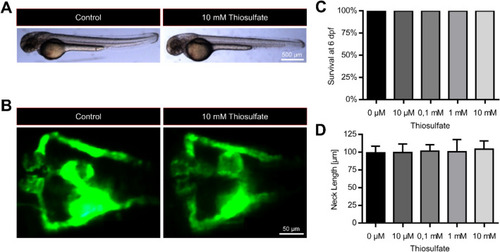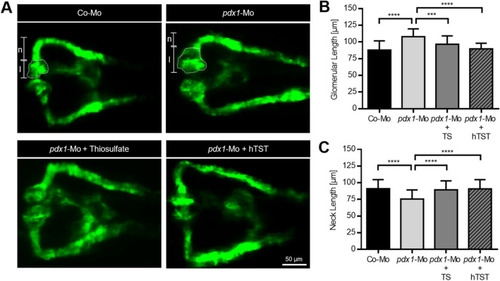- Title
-
Thiosulfate sulfurtransferase prevents hyperglycemic damage to the zebrafish pronephros in an experimental model for diabetes
- Authors
- Al-Dahmani, Z.M., Li, X., Wiggenhauser, L.M., Ott, H., Kruithof, P.D., Lunev, S., A Batista, F., Luo, Y., Dolga, A.M., Morton, N.M., Groves, M.R., Kroll, J., van Goor, H.
- Source
- Full text @ Sci. Rep.
|
Thiosulfate exposure does not affect viability or pronephros morphology in healthy zebrafish larvae. (A) Representative overview of the zebrafish appearance at 48 hpf with and without 10 mM thiosulfate. Zebrafish embryos exposed to 10 mM thiosulfate did not show any gross morphological changes compared to controls. (B) Representative visualization of the pronephros phenotype in Tg(wt1b:EGFP) embryos at 48 hpf with and without 10 mM thiosulfate. Thiosulfate did not have any visible effect on the pronephros morphology compared to controls. (C) Evaluation of the survival in zebrafish larvae exposed to thiosulfate for 6 days. Thiosulfate did not lead to any detrimental effects regarding survival in any of the studied concentrations (n?=?15 for each condition). (D) Evaluation of the pronephric neck length in Tg(wt1b:EGFP) embryos at 48 hpf exposed to different thiosulfate concentrations. Thiosulfate did not significantly alter the pronephric neck length in healthy zebrafish larvae (at least 10 larvae per group were analyzed). Scale bars are 500 ?m in (A) and 50 ?m in (B). Statistics utilized one-way ANOVA?+?Sidak?s post-hoc (D); mean?+?SD reported; *p?<?0.05. |
|
Thiosulfate and human thiosulfate sulfurtransferase treatment rescues pdx1 morpholino-induced hyperglycemic pronephros damage. (A) Representative visualization of the zebrafish pronephros in Tg(wt1b:EGFP) embryos at 48 hpf with different experimental conditions. Embryos injected with only a control morpholino (Co-Mo) show the typical pronephros morphology at 48 hpf, while injection with the pdx1 morpholino (pdx1-Mo) leads to a hyperglycemia-mediated pronephros phenotype with an increased glomerular length and a shortened pronephric neck length. Treatment via either exposure to 10 mM thiosulfate (TS) or injection of 1 nl human thiosulfate sulfurtransferase (hTST) at a concentration of 1 µg/µL rescued the pronephros phenotype in the pdx1 morphants. (B?C) Evaluation of the pronephros phenotype in Tg(wt1b:EGFP) embryos at 48 hpf shows significant rescue of both (B) glomerular length and (C) pronephric neck length by TS and hTST treatment in pdx1 morphants (n?=?45 for Co-Mo and pdx1-Mo, n?=?30 for the TS and hTST groups). Measurements for glomerular length (l) and pronephric neck length (n) have been marked and the glomerulus was encircled for one pronephric side in two images in (A) as example. Lengths given in (B?C) represent the total sum of both the left and right side measurements added up. The scale bar is 50 ?m in (A). Statistics utilized one-way ANOVA?+?Sidak?s post-hoc (B?C); mean?+?SD reported; ***p?<?0.001, ****p?<?0.0001. PHENOTYPE:
|


